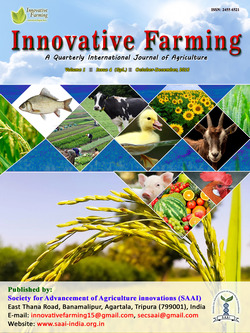
Management of Lipaphis erysimi (Kalt.) Using Newer Insecticides and Bio-Pesticides in Radish
Megaladevi, P.*
Department of Agricultural Entomology, AC&RI, TNAU, Coimbatore-641003. Tamil Nadu, INDIA
M. Manjunatha
College of Agriculture, UAHS, Shivamogga- 577225, Karnataka, INDIA
DOI: NIL
Keywords: Biopesticides, Insecticides, Lipaphis erysimi, Radish
Abstract
At present, there is a great deal of discussion on the resistance and resurgence of insects to commonly used insecticides which is of grave concern in crop protection. One of the solutions to the resistance problem is the rotation of newer insecticides with the conventional ones. Hence, an attempt has been made to evaluate newer insecticides and bio-pesticides to manage aphids Lipaphis erysimi (Kalt.) in radish. The field experiment was laid out in randomized block design (RBD) with three replications and 10 treatments with a plot size of 3 m x 2 m. In each plot, five plants were selected and tagged. The first spray was given after 18 days of sowing when sufficient buildup of aphid population was seen. Emamectin benzoate 5 SG @ 0.5 g/l was used as a blanket application for the management of defoliators. From each tagged plant, three leaves were selected from the upper, middle and lower part for counting the number of aphids per leaf with help of magnifying lens and the mean population of aphids per plant was worked out. Aphid population was recorded at one day before, three, seven and fourteen days after application of insecticides. The tuber yield per plant was recorded at each harvest separately for each treatment and the yield is converted to kg/plot. Obtained data were analyzed using ANOVA. Thiamethoxam, imidacloprid, and dimethoate were best and effective chemicals in reducing the population of aphids, whereas the two microbial pesticides were found to be less effective.
Downloads
not found
Reference
Abdu-Allah, G. 2012. Aphicidal activity of imidacloprid and primicarb compared with certain plant extracts on Brevicoryne brassicae L. and Aphis craccivora Koch. Assiut J. Agric. Sci., 43:104–114.
Aslam, M. and M. Ahmad. 2004. Effectiveness of some insecticides against cabbage aphid, Brevicoryne brassicae (Linnaeus) (Aphididae: Homoptera). J. Res. (Science), Bahauddin Zakariya University, Multan, Pakistan, 13(2):145-150.
Dhawan, A.K., S. Sarika and A. Anan. 2008. Relative toxicity of different insecticides against cotton aphid, Aphis gossypii Glover. Environ. Ecol., 26(4B): 2067–2069.
El-dewy, M.H.E., 2006. Toxicological studies on some pests attacking cotton. Ph.D. Thesis, Fac. Agric., Kafr El-Sheikh Univ., Egypt, pp. 101.
Gami, J.M., J.G. Bapodra and R.R. Rathod. 1980. Chemical control of mustard aphid, Lipaphis erysimi Kaltenbach. Indian J. Pl. Prot., 8(2):151-53.
Das, G. 2013. Efficacy of imidacloprid, a nicotinoid group of insecticide against the infestation of chilli aphid, Myzus persicae (Hemiptera: Aphididae).Int. J. Biol. Sci., 2(11):154-159.
Gour, I.S. and B.L. Pareek. 2003. Field evaluation of insecticides against mustard aphid, Lipaphis erysimi (Kalt.) under semi-arid region of Rajasthan. Indian J. Pl. Prot., 31(2):25-27.
Halder, J., M.H. Kodandaram and A.B. Rai. 2011. Differential responses of major vegetable aphids to newer insecticide molecules. Vegetable Sciences, 38(2):191-193.
El-Naggar., J.B. and N.E.H.A. Zidan. 2013. Field evaluation of imidacloprid and thiamethoxam against sucking insects and their side effects on soil fauna. J. Pl. Prot. Res., 53(4):375-388.
Misra, H.P. 2002. Field evaluation of some newer insecticides against aphids (Aphis gossypii) and jassids (Amrasca biguttula) on okra. Indian J. Entomol., 64(1): 80–84.
Rouhani, M., M.A. Samih, H. Izadi and E. Mohammadi. 2013. Toxicity of new insecticides against pomegranate aphid, Aphis punicae. International Research Journal of Applied and Basic Sciences, 4(3): 496-501.
Schroeder, N.C., A.J Dumbleton and S.M. Zydenbos. 2001. Thiamethoxam seed coating on rapeseed for the control of cabbage aphid, Brevicoryne brassicae(L.). N.Z. Pl. Prot. 54:240-243.
Sekhon, S.S., S.S. Sajjan and U. Kanta. 2008. Chemical control of mustard aphid, Lipaphis erysimion seed crop of radish. J. Entomol. Res. 32(1):41-43.
Singh, A. and M.N. Lal. 2011. Ecofriendly approaches for management of mustard aphid, Lipaphis erysimi (Kalt.). M.Sc. (Ag.) Thesis, NDUA&T, Faizabad, India.
